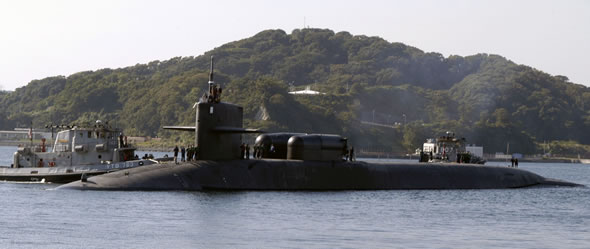
With proposed defense budget reductions creating a need to reshape American military forces, the US Department of Defense is once again looking into the possibility of developing a sub-launched “Prompt Global Strike” (PGS) weapon as a means of reinforcing America’s power projection capability.
Secretary of Defense Leon Panetta announced during a press conference on January 26 that the administration’s proposed Fiscal Year 2013 budget request of $525 billion includes funding for the US Navy to renew efforts to develop a non-nuclear, sub-launched missile capable of striking a target anywhere in the world within an hour of launch. The only weapons presently available in the inventory capable of hitting global targets so quickly are nuclear Intercontinental Ballistic Missiles (ICBMs). ICBMs are subject to severe restrictions regulating their numbers, deployment, warhead capacity, and range by multiple international treaties.

Back in 2000, the US Navy attempted to adapt the D-5 Trident missile for use as a Prompt Global Strike weapon, but met with strong opposition from members of the Senate Armed Services Committee. Committee members, and other legislators, expressed their concern that the launch of a modified non-nuclear Trident would be mistaken for a nuclear strike and could potentially spark a nuclear retaliatory strike from Russia.
During the January 26 press conference, Chairman of the Joint Chiefs of Staff General Martin Dempsey assured the audience that advances in missile technology now made it possible for a purpose-built PGS weapon to be sufficiently recognizable so it would not be mistaken for a nuclear strike. He indicated that Navy engineers now had the technology to develop a missile with a distinctive trajectory and trademark speed that would preclude the possibility of mistaken identity.
The Department of Defense’s renewed interest in development of a sub-launched PGS is tacit recognition that advanced conventional weapons are needed to meet the security demands of the new century to maintain US military superiority. Such weapons are sparking increased interest as fiscal reality forces a reduction in American forces and weaponry.
Defense sources have long lobbied for deployment of a non-nuclear PGS weapon, arguing that such a weapon would be invaluable for taking out high-profile targets like Osama Bin Laden quickly and with minimal risk to combat forces. Such a weapon would also serve to bolster the Defense Department’s missile defense shield and would add a much needed warfighting capability ideally suited for service with a smaller, more flexible US military force.
In his address, Mr. Panetta did not provide any specifics regarding the ships expected to carry a PGS weapon. It is not yet known if the Navy plans to deploy the PGS missiles aboard the older Ohio-class subs or the newer Virginia-class submarines or both.



















